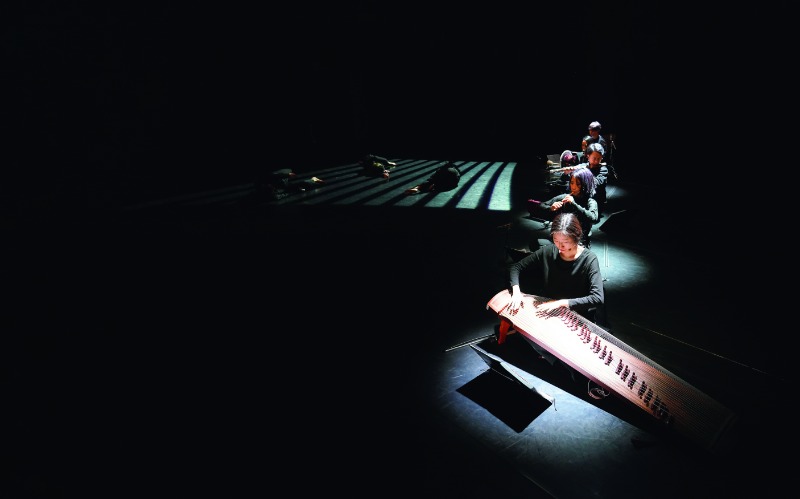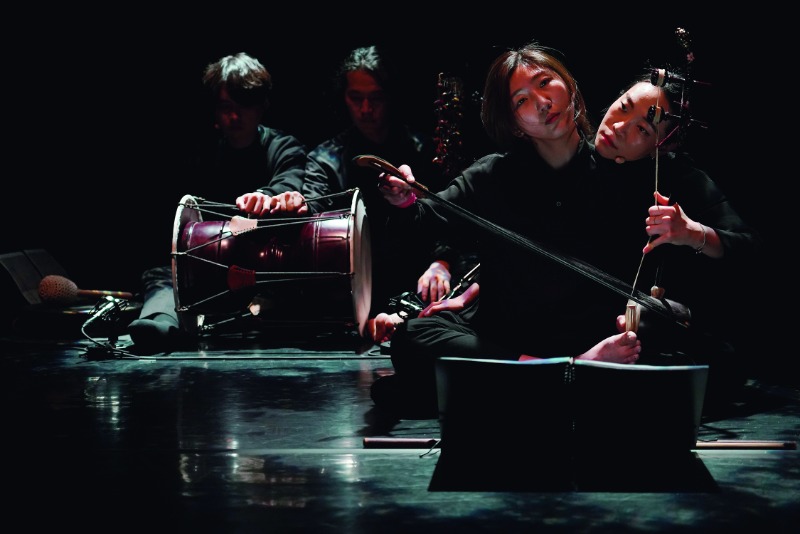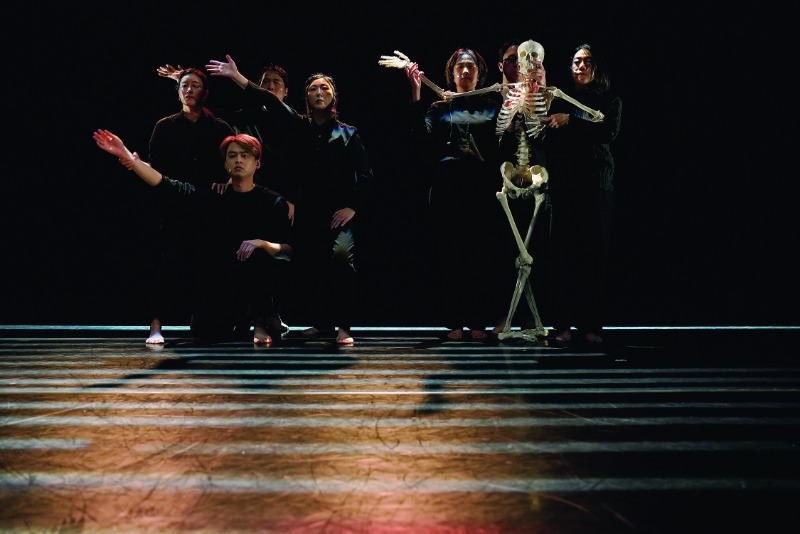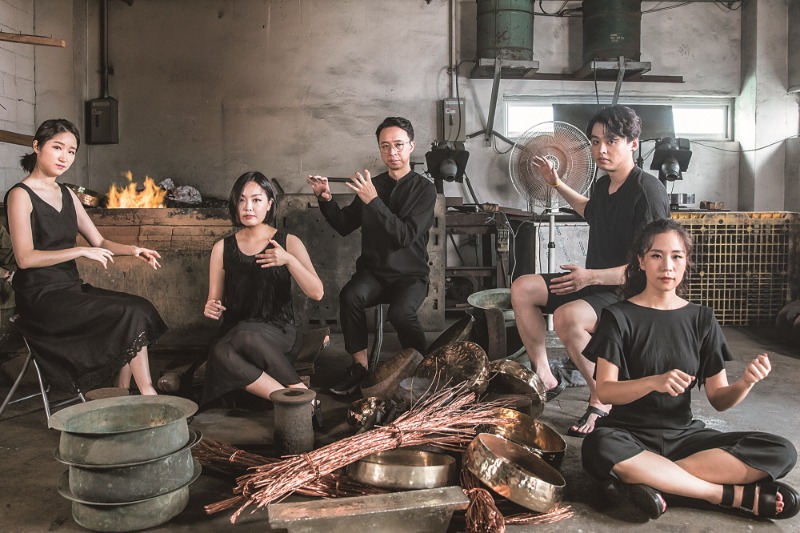“Kkokdugaksi” is a collaborative work by Music Coterie Gomool and dance troupe Goblin Party. Their experimental, genre-crossing performance has instrumentalists dance and dancers play instruments, going beyond the simple formula of combining traditional music and contemporary dance to question and challenge the conventions of both genres.

Usually when music is played in collaboration with other genres, it is used either to inspire the audience’s emotions or as background music. “Kkokdugaksi” is a collaborative work where the music and dance genres do not suppress one another but instead form a partnership that emphasises the overall message of the piece.
Courtesy of Arts Council Korea, Photo by Ok Sang-hoon
Collaboration is one of the defining concepts of Korea’s contemporary performing arts scene. Recently, there has been a surge in works characterized by the blending of different genres, which is novel in itself and remarkable in terms of the performers it brings together. However, merely combining different genres does not guarantee that a collaboration is worthwhile; the most important factor is the end result.
For collaborative art to succeed, a power balance must be struck. If the work fails to offer a compelling rationale behind the marriage of genres, it may be perceived merely as a form of simple entertainment. In that regard, “Kkokdugaksi” warrants our undivided attention; it has been described as the best collaborative work of our times and has opened up new possibilities for such partnerships.
The Arts Council Korea (ARKO) is dedicated to discovering new creative performances. In 2021, “Kkokdugaksi” was selected as one of the New Works of the Year in the traditional arts category of ARKO Selection, an artist support program. Having premiered in February 2022 at the Daehakro Arts Theater, “Kkokdugaksi” was performed in a showcase for the Performing Arts Market in Seoul (PAMS), an international performing arts platform held in September, and was invited to the Seoul Performing Arts Festival in October.
One-of-a-Kind

The performance features scenes where the roles of the performers for each genre are disintegrated or subverted such as when the dancers manipulate the instrumentalists and intervene in the play. The audience begins to question the identities of the manipulators and manipulated, respectively. At the same time, the members of the audience take a moment to reflect on the social system in which they live.
Courtesy of Arts Council Korea, Photo by Ok Sang-hoon
Based on traditional music, “Kkokdugaksi” is a collaborative piece by Music Coterie Gomool and the three choreographers of dance troupe Goblin Party. News of the two groups working together raised expectations that something intriguing would unfold.
Headed by music director Lee Tae-won, Gomool comprises seven performers who all majored in traditional Korean music. They seek answers to their questions in the experimental format of a “staged documentary.” Constantly considering how traditional Korean music should be understood in contemporary times, the group creates works that critically review the concepts, institutions, rules, and systems governing traditional music.
For some time, Gomool has demonstrated the potential of creators imagining what lies between systems or, indeed, beyond the systems themselves. Its members questioned the reason for orthodoxy in current ways of thinking, and why particular genre combinations were not considered. “Kkokdugaksi” is an extension of this line of thought.
Goblin Party appropriately takes on the identity of goblins. Korean goblins are both gifted and merry in character, and they symbolize productivity and abundance. Goblin Party is a collective of three choreographers who steer clear of hierarchy in their creative process and have already produced a sundry of works. The team is considered unique, and many regard the idiosyncratic collaboration between music and dance embodied in “Kkokdugaksi” as a sensation.
Tearing Down and Crossing Borders

The audience can only speculate on the length and depth of the dialogues the five instrument players and three choreographers must have engaged in as they collaborated to produce a perfect ensemble.
Courtesy of Arts Council Korea, Photo by Ok Sang-hoon
The uniqueness of the two teams’ partnership is directly reflected in the subject of the performance. Kkokdugaksi refers to a dance — commonly performed by children in kindergarten plays or at sports day events at elementary schools — and its musical accompaniment. The average middle-aged Korean likely has memories of taking part in this dance or watching some form of it. The term also refers to a traditional puppet play, performed by troupes of male entertainers called namsadang. During the Joseon Dynasty, these troupes wandered around the country, putting on folk music performances, including song and dance. As a puppet, Kkokdugaksi also embodies the idea of manipulation, like the Western marionette. These diverse meanings and contexts form the basis of “Kkokdugaksi,” in which the movements, acting, music, and passive puppet motifs are assembled in a free and intuitive way.
Hence, “Kkokdugaksi” both subverts and divides the existing rules. For example, the musicians and dancers on stage come together such that their roles are blurred. Musicians rise from their seats and break into dance, while dancers play instruments. The movements of playing instruments become dance movements, and sometimes the subject and object are strangely distorted when the dancers intervene in the instrumental performance. The music voluntarily becomes movement, the dancers become music, and the musician becomes the object, leaving music, dance, and theater in apparent disarray, but not separated from one another. Hence, the genre boundaries collapse on many levels.
The audience attempts to define the work as either one of the two collaborating genres, which leads them to question the conceptual framework they had, up to that point, internalized. Hence, “Kkokdugaksi” serves to disintegrate and reassemble the rules of each genre and should be embraced neither as music nor dance. This process evokes strange feelings, leading audiences to ask themselves fundamental questions such as “What are music, dance, and theater?” and “How are their concepts similar and how are they different?”
Negotiation Table

Profile photo taken before Music Coterie Gomool’s video shoot in 2020 during the group’s participation in the National Gugak Center’s music video production project. (From left) Hong Ye-jin on gayageum, Lee Yu-gyeong (guest) on haegeum, Go Jin-ho on daegeum, Jeong Jun-gyu (guest) on janggu, Bae Seung-bin on piri. Since its formation in 2006, Gomool has created work that critically reviews controversial and difficult topics surrounding traditional music.
ⓒ National Gugak Center
“Kkokdugaksi” is not simply a combination of contemporary dance and traditional music. While most collaborative work converges towards a juxtaposition of different genres, “Kkokdugaksi” is unique in that the nuanced puppet motif serves as a critical link in the collaboration between the two teams. In addition, exploration of the music and movements created in the process must have served as the foundation for reconstructing familiar notions of Kkokdugaksi from a new perspective.
Collaboration between music and other genres begins by considering the potential that music offers to the partnership. Gomool and Goblin Party’s “Kkokdugaksi” represents a redefinition of the genre rules, resulting from ceaseless negotiation at each end of the genre boundaries, instead of simply their erasure. The key is the inner strengths of the two teams.
In “Kkokdugaksi,” the two genres alternate in taking the lead or following, coordinating the overall flow of the performance. The level of detail is quite impressive; even when the movement is in the foreground, the role of the music can still be clearly detected. Despite its genre-bending nature, “Kkokdugaksi” achieves the difficult feat of creating something new while maintaining the unique characteristics of the traditional and the contemporary. The long and intense dialogues that surely took place during the planning of the show ultimately led to a performance that celebrates true collaboration.
Seong Hye-inMusic critic